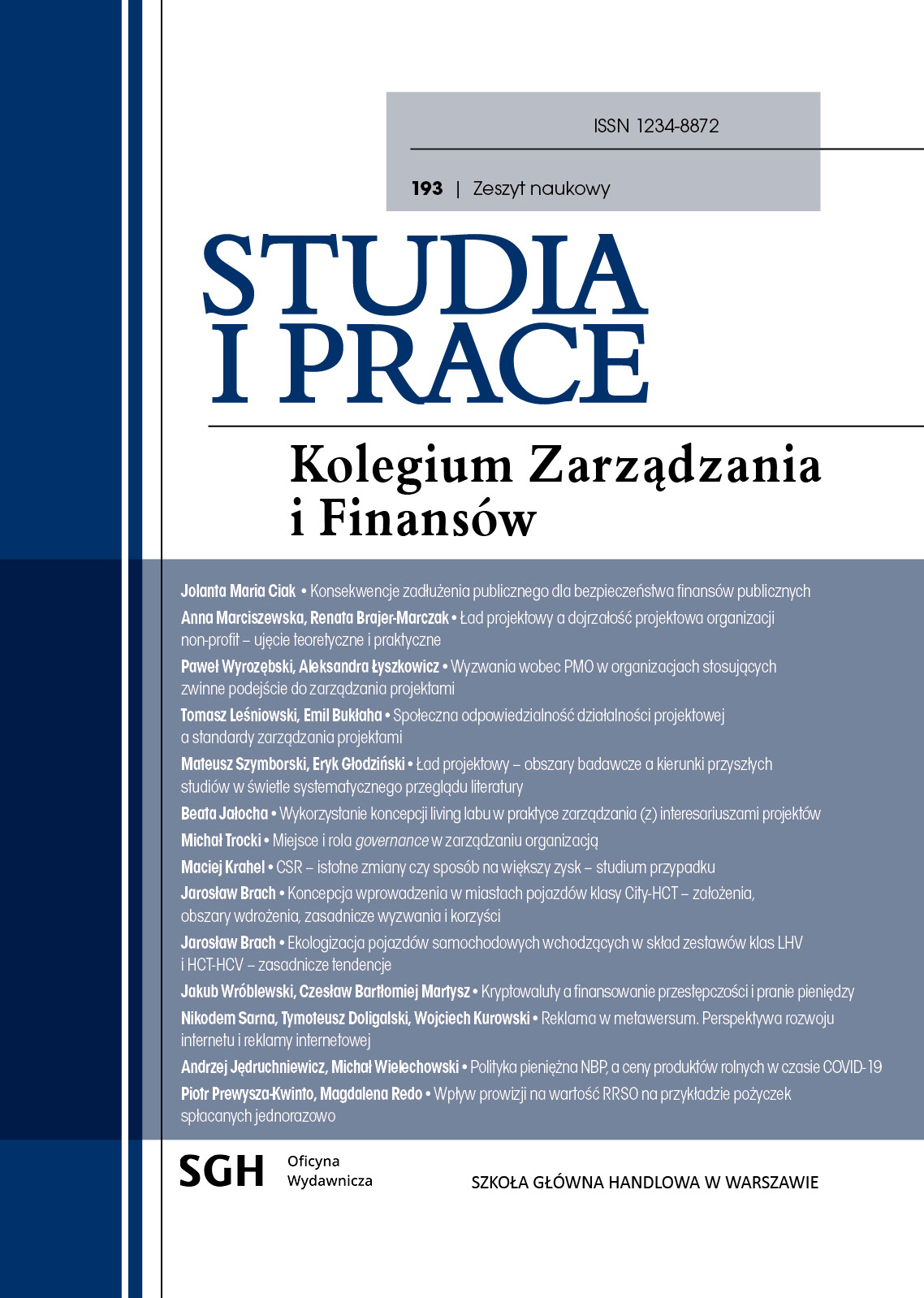Reklama w metawersum. Perspektywa rozwoju internetu i reklamy internetowej
DOI:
https://doi.org/10.33119/SIP.2023.193.12Słowa kluczowe:
metaverse, światy wirtualne, reklama, internet, blockchainAbstrakt
Metawersum to zbiorcze określenie wirtualnych światów umożliwiających użytkownikom podejmowanie interakcji, budowę społeczności oraz zapewniających im rozrywkę. W artykule przedstawiono reklamę w metawersum z perspektywy etapów rozwoju internetu, reklamy internetowej oraz zastosowania technologii blockchain w reklamie. Wykorzystaną metodą badawczą były studia literaturowe oraz wywiady pogłębione z przedstawicielami firm zajmujących się reklamą internetową, reklamą w metawersum oraz technologią blockchain. Z badań wynika, że reklama w metaświatach nosi wiele charakterystyk reklamy internetowej z jej wczesnych etapów rozwoju. Zdaniem respondentów, reklama w metawersum charakteryzuje się jednakże większą immersyjnością, nastawiona jest bardziej na długookresową budowę marki, obarczona jest większym ryzykiem związanym z kontekstem jej wyświetlenia. Typowym reklamodawcą w metawersum jest duża firma o wypracowanej marce działająca na rynku odbiorców indywidualnych.
Downloads
Bibliografia
Adshares [2017], Adshares Whitepaper, https://adshares.net/docs/adshares_whitepaper.pdf (dostęp: 10.11.2022).
Adshares [2022], Adshares – a three-layer complete sandbox for your web3 transition, https://adshares.net/ecosystem (dostęp: 12.11.2022).
Alabdulwahhab F. A. [2018], Web 3.0: The Decentralized Web Blockchain networks and Protocol Innovation, 1st International Conference on Computer Applications & Information Security (ICCAIS), s. 1–4.
Ambire [2022], Ambire is a tech innovator, https://www.ambire.com/about/company (dostęp: 10.11.2022).
Atlas Protocol [2019], Atlas Protocol Light Paper. Defining blockchain interactive advertising & marketing, https://atlasp.io/docs/atlas-protocol-light-paper.pdf (dostęp: 10.11.2022).
Basic Attention Token [2021], Basic Attention Token (BAT]. Blockchain Based Digital Advertising, https://basicattentiontoken.org/static-assets/documents/BasicAttentionTokenWhite-Paper-4.pdf (dostęp: 10.11.2022).
Busch O. [2016], The Programmatic Advertising Principle, w: Programmatic Advertising – The Successful Transformation To Automated Data-Driven Marketing in Real-Time, Springer International Publishing Switzerland, s. 3–15.
Chin-Tsai L., Pi-Fang H. [2003], Adopting an analytic hierarchy process to select Internet advertising networks, „Marketing Intelligence & Planning”, vol. 21 (3), s. 183–191.
Cramer-Flood E. [2022], Worldwide Ad Spending 2022, https://www.insiderintelligence.com/content/worldwide-ad-spending-2022 (dostęp: 8.08.2022).
DATA [2019], DATA. Decentralized AI-Powered Trust Alliance, https://docsend.com/view/pk5w8 wx (dostęp: 10.11.2022).
Deloitte Insights [2020], The Spatial Web and Web 3.0, https://www.oreilly.com/pub/a/web2/archive/what-is-web-20.html (dostęp: 26.09.2022).
Doligalski T. [2001], Cyberbranding, czyli jak zbudować marką w Internecie? „Brief ”, no. 4.
Doligalski T., Goliński M., Kozłowski K. [2021], Disruptive Platforms: Markets, Ecosystems, and Monopolists, Routledge, Oxon.
EOS.IO [2018], EOS.IO Technical White Paper v2, https://github.com/EOSIO/Documentation/blob/master/TechnicalWhitePaper.md (dostęp: 18.09.2022).
Fulgoni G. M. [2016], Fraud in Digital Advertising: A Multibillion-Dollar Black Hole, „Journal of Advertising Research”, vol. 56 (2), s. 122–125.
Gibson M. [2012], Online display advertising – then and now…, http://www.vantagelocal.com/history-of-online-display-advertising-2/ (dostęp: 26.06.2022).
Gregolinska E., Khanam R., Lefort F., Parthasarathy P. [2022], Capturing the True Value of Industry 4.0, McKinsey & Company, https://www.mckinsey.com/capabilities/operations/ourinsights/capturing-the-true-value-of-industry-four-point-zero (dostęp: 26.08.2023).
Hackl C., Lueth D., Di Bartolo T. [2022], Navigating the Metaverse. A guide to limitless possibilities in a Web 3.0 world, John Wiley & Sons, Hoboken, New Jersey.
IAB Polska [2022], Raport Strategiczny. Internet 2021/2022, https://raportstrategiczny.iab.org.pl/ (dostęp: 9.09.2022).
Karame G. [2016], On the security and scalability of Bitcoin’s blockchain, w: Proceedings of the 2016 ACM SIGSAC Conference on Computer and Communications Security, CCS, ACM, New York, s. 1861–1862.
Keen A. [2007], Kult amatora. Jak Internet niszczy kulturę, Wydawnictwa Akademickie i Profesjonalne, Warszawa.
Kennedy A. [2000], Internet. Praktyczny przewodnik.
Leiner B. M., Cerf V. G., Clark D. D., Kahn R. E., Kleinrock L., Lynch D. C., Postel J., Roberts L. G., Wolff S. S. [1997], The past and future history of the Internet, „Communications of the ACM”, vol. 40 (2), s. 102–108.
Markarian R., Park A., Grether M. [2016], Borderless Media Management, w: Programmatic Advertising – The Successful Transformation To Automated, Data-Driven Marketing in Real-Time, Springer International Publishing Switzerland, s. 17–23.
Marvin G. [2015], MarTech Landscape: What Is An Ad Network? https://martech.org/martech-landscape-what-is-an-ad-network/ (dostęp: 8.08.2022).
Mider D. [2015], Mappa Mundi ukrytego Internetu. Próba kategoryzacji kanałów komunikacji i treści, „PTINT Praktyka i Teoria Informacji Naukowej i Technicznej”, nr 23.
Nakamoto S. [2008], Bitcoin: a peer-to-peer electronic cash system, https://bitcoin.org/bitcoin.pdf (dostęp: 18.09.2022).
O’Reilly T. [2005], What is Web 2.0, https://www.oreilly.com/pub/a/web2/archive/what-isweb-20.html (dostęp: 25.09.2022).
O’Reilly T. [2009], What is Web 2.0. Design Patterns and Business Models for the Next Generation of Software, O’Reilly Media, Sebastopol, California, USA.
O’Reilly T. [2022], The Metaverse Is Not a Place. It’s a communications medium, https://www.oreilly.com/radar/the-metaverse-is-not-a-place/ (dostęp: 26.08.2023).
Oberoi A. [2013], The History of Online Advertising, https://www.adpushup.com/blog/thehistory-of-online-advertising/ (dostęp: 26.06.2022).
Paul P. [1996], Marketing on the Internet, „Journal of Consumer Marketing”, vol. 13 (4), s. 27–39.
Pawlata H., Cakir G. [2020], The Impact of the Transparency Consent Framework on Current Programmatic Advertising Practices, w: Proceedings of the 4th International Conference on Computer-Human Interaction Research and Applications – vol. 1: WUDESHI–DR, s. 331–336.
Popescu A.‑D. [2021], Non-Fungible Tokens (NFT) – Innovation beyond the craze, 5 th International Conference on Innovation in Business, Economics & Marketing research (IBEM-2021) Proceedings of Engineering & Technology – PET – vol. 66, s. 26–30.
Pudełko M. [2020], Prawdziwa histori@ Internetu, Itstart Wydawnictwo Informatyczne.
Rouhani S., Deters R. [2017], Performance analysis of ethereum transactions in private blockchain, w: 2017 8th IEEE International Conference on Software Engineering and Service Science (ICSESS), November, s. 70–74.
Sarowski Ł. [2017], Od Internetu Web 1.0 do Internetu Web 4.0 – ewolucja form przestrzeni komunikacyjnych w globalnej sieci, „Rozprawy Społeczne”, nr 11 (1), s. 32–39.
Templeton B. [2008], Reflections on the 25th Anniversary of Spam, http://www.templetons. com/brad/spam/spam25.html (dostęp: 26.06.2022).
Yang W., Garg S., Raza A., Herbert D., Kang B. [2018], Blockchain: trends and future, w: PKAW 2018. LNCS (LNAI), vol. 11016, Springer, Cham, s. 201–210.
Yuan Y., Wang F., Li J., Qin R. [2014], A survey on real time bidding advertising, Proceedings of 2014 IEEE International Conference on Service Operations and Logistics, and Informatics, s. 418–423.
Zheng Z., Xie S., Dai H., Chen X., Wang H. [2017], An overview of blockchain technology: architecture, consensus, and future trends, w: 2017 IEEE International Congress on Big Data (BigData Congress), IEEE, s. 557–564.
Pobrania
Opublikowane
Wersje
- 2024-03-20 - (2)
- 2023-12-06 - (1)
Jak cytować
Numer
Dział
Licencja
Prawa autorskie (c) 2023 Studia i Prace Kolegium Zarządzania i Finansów

Utwór dostępny jest na licencji Creative Commons Uznanie autorstwa 4.0 Międzynarodowe.









